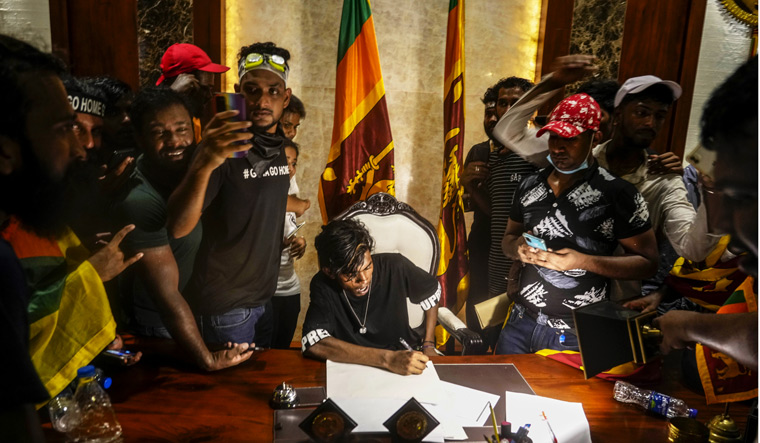During Easter this year, Sri Lankan playwright, theatre director and screenwriter Ruwanthie de Chickera received a call from a priest: “How would it be if a priest could wash a protester’s feet?”
Though not religious, Ruwanthie found the idea brilliant: a nod to Jesus washing the feet of his disciples before the Last Supper. It resonated with the people.
Ruwanthie practises the ‘devising’method of theatre-making, which involves creative collaboration with and improvisation by the performing ensemble. Yet, she is unable to believe how things unfolded in Sr Lanka in the past four months. What began as a number of small street protests of three or four people against the Sri Lankan government blew up into a movement that came to be known as Aragalaya (struggle).
As the protest began on April 9 at the Galle Face Green, close to the Presidential Secretariat in Colombo, Ruwanthie, 46, met people from various walks of life, including many from her own fraternity whom she had not met in her 20-year-long career in theatre. And even those she had met earlier, she had never talked politics with them; Gota Go Gama (protest site) changed all that.
“A group of artists sat together to discuss what we can do to inject courage and inspiration into the movement,”she says.
On July 9, protesters stormed President Gotabaya Rajapaksa’s residence and, on July 13, he fled the country. The storming was unexpected; the expectation was that 10,000 people to show up at the protest site. "People came in by themselves,”says Ruwanthie. “GotaGoGama only created the opportunity.”
Edited excerpts from an interview:
Q. Why do you think the Aragalaya movement began?
A. Each decade, since independence, politicians in power have got worse. The lowest point was when the Rajapaksas came to power. There was deterioration in human rights, in accountability…. The Rajapaksas wanted to rule like kings, and democracy meant nothing to them. They were not interested in institutions.
In 2015, a national government came in, but it did not take any action against the Rajapaksas. Rain Wikremesinghe was then prime minister. The Easter bombing attacks of 2019 seemed contrived, and then extremely quickly the Rajapaksas returned to power.
If Covid-19 had not happened, they would have not been exposed; they would have continued to steal. It was only three or four weeks ago that the food crisis committee in Sri Lanka met for the first time in the last one and a half years. The reason was that the government was not admitting that there was a crisis. This is what happens when you have an all powerful president. Basically, ineffective governance was the reason for the crisis.
Q. How was the movement organised?
A. The Aragalaya movement started on its own, because people were fed up. There is no organising to it. It is like how drops of water come together and suddenly make a river. It was people who started protesting as the food and fuel crisis began. This was happening for more than a month or so. This went unnoticed.
But when the power cuts happened, people reached the president’s [private residence] in Mirihana. But even then he did not realise. He sent the military, put curfew. The military attacked the protesters.
Luckily, social media brought out all this against the president. He declared emergency, which angered the people further. The Bar Association of Sri Lanka, the fantastic legal guardians of Sri Lanka, got the curfew revoked.
The [watershed] moment was when he [tried] to stifle the protest, [and] everybody just turned up at Galle Face. That was on April 9. Nobody expected such a massive outpouring. It happened very organically. Ours is a country which doesn’t have a very strong protest culture.
People stayed on in Gall Face after April 9. At night, they put up tents. The next morning, someone put up a board, saying Gota Go Gama (gama means village). This was very inspiring, as till then the protest was held together by just the slogan ‘Go Home Gota’. So when this idea came up, people just flocked to it. They started a library, people parliament, medical centre, school, LGBTQ tent—partly in rejection of the system, the government and the Rajapaksas, but also to create a parallel Sri Lanka that we wanted to live in.
And, on May 9, there was the attack on the protesters. It raised the stakes. It made things very dangerous, created a lot of conflict and, from May 9 to July 9, there was a steady decline in the number of people coming to the protest. Ranil Wickremesinghe came in and propped up a dying government. Otherwise there was a possibility that these guys would have been out two months earlier. Ranil had lots of supporters, a lot of business community supporters, and he has a different way of politics—he is seen as a neo-liberalist.
Q. You are seen as one of the key persons in Aragalaya. How did that happen?
A. It was a people’s movement. There are no leaders. It is a decentralised movement and that is the power and the beauty of it. It is only based on consensus and the country’s welfare. Even when the speaker of the parliament asked 20 people from Aragalaya to come for a meeting with parliament, people said we are not going, because nobody is leading this. There are no key persons. But there are thousands of people working wholeheartedly and passionately. I am one of them.
Q. How did the July 9 incident come about?
A. We did not know that was going to happen. I estimated about 10,000 people would come. We did not expect this big a crowd. But we worked very hard to tell people about their rights. We did not have money to organise buses. People came in by themselves. They walked for miles. Some for days. GotaGoGama only gave them the opportunity and the space to protest.



